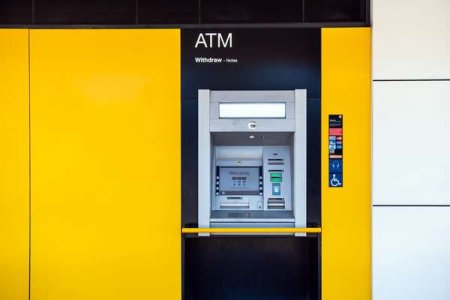The shocking truth behind Commonwealth Bank's new 'cashless branches'
By
Seia Ibanez
- Replies 71
The Commonwealth Bank of Australia (CBA), the nation's largest home lender, is making waves—and raising more than a few eyebrows—with its new 'cashless' branches.
But what's the real reason behind this move?
Is it a sign of the times or a strategic move to cut costs and push customers towards digital banking? Let's delve into the details.
The CBA has been opening what it calls 'specialist centres' across the country.
These centres, referred to as 'services centres' in the bank's annual report, are different from traditional branches.
The most significant difference? Tellers at these centres are not allowed to handle cash transactions over the counter.
However, the bank is quick to refute the term 'cashless', arguing that these centres are not devoid of cash as they house ATMs for customers to withdraw and deposit money.
The bank's spokesperson said, ‘Specialist centres are designed to support personal and business customers with more complex banking needs.’
'Customers are able to withdraw and deposit cash at all of our specialist centres, and referring to them as cashless would be inaccurate.’
'While specialist centres don't have (sic) traditions telling counters, cash remains available for withdrawal and deposit at each location via on-site ATMs.'
A member of Daily Mail Australia visited a ‘specialist centre’ in Barangaroo in Sydney, but the teller told her she could not do a cash transaction.
The first of these specialist centres opened in 2020 at South Everleigh, Sydney, amidst the pandemic, which saw a significant shift from cash to tap-and-go payments.
Since then, more centres have sprung up in major cities like Sydney, Melbourne, and Brisbane, with a Bankwest outlet in Perth.
The bank's annual report for 2022-23 listed 741 branches and 'services centres', a grouping observers say masks the extent of traditional bank closures.
Over the past five years, the Commonwealth Bank has closed 354 traditional branches that handle cash transactions, a move that coincides with the decline in cash usage in Australia.
According to a Reserve Bank of Australia report, the proportion of in-person transactions done in cash fell to 16 per cent in 2022, down from 32 per cent in 2019, before the pandemic.
This decline in cash usage has also led to the removal of 2,297 ATMs between 2018 and 2023, a staggering 54 per cent decrease.
The bank's CEO, Matt Comyn, has been candid about the cost of maintaining cash availability.
'Transporting and making cash available around our vast country involves considerable expense of logistics and security,' he said.
'We estimate that continuing to support distribution and availability of cash costs CBA approximately $ 400 million each year, which works out to be roughly $40 for every one of our 10 million customers.’
'Many of our customers don't use cash, though, and these customers cross-subsidise those that do.’
'As time goes on, it becomes unsustainable to invest substantial resources, keeping expensive services that fewer and fewer customers use.'
Comyn also told the parliamentary committee, ‘An ATM costs around $30,000 per year to operate. In the six years since fees were removed, the number of major banks with ATMs in Australia has more than halved.’
Over the past five years, CBA closed 354 traditional branches that do cash transactions from 1,082 in June 2018.
Recently, CBA added the closure of three more branches across the country—Coogee, New South Wales, Coolangatta, Queensland, and Adelaide’s Rundle Mall in South Australia. These branches are set to close their doors permanently by March 1.
The Commonwealth Bank promised not to close any of its specialist centres outside the capital city until 2026.
Other big banks like National Australia Bank and ANZ are also trying out branches without cash services.
 What are your thoughts on this shift towards cashless banking? Have you visited one of these 'specialist centres'? Share your experiences and opinions in the comments below.
What are your thoughts on this shift towards cashless banking? Have you visited one of these 'specialist centres'? Share your experiences and opinions in the comments below.
But what's the real reason behind this move?
Is it a sign of the times or a strategic move to cut costs and push customers towards digital banking? Let's delve into the details.
The CBA has been opening what it calls 'specialist centres' across the country.
These centres, referred to as 'services centres' in the bank's annual report, are different from traditional branches.
The most significant difference? Tellers at these centres are not allowed to handle cash transactions over the counter.
However, the bank is quick to refute the term 'cashless', arguing that these centres are not devoid of cash as they house ATMs for customers to withdraw and deposit money.
The bank's spokesperson said, ‘Specialist centres are designed to support personal and business customers with more complex banking needs.’
'Customers are able to withdraw and deposit cash at all of our specialist centres, and referring to them as cashless would be inaccurate.’
'While specialist centres don't have (sic) traditions telling counters, cash remains available for withdrawal and deposit at each location via on-site ATMs.'
A member of Daily Mail Australia visited a ‘specialist centre’ in Barangaroo in Sydney, but the teller told her she could not do a cash transaction.
The first of these specialist centres opened in 2020 at South Everleigh, Sydney, amidst the pandemic, which saw a significant shift from cash to tap-and-go payments.
Since then, more centres have sprung up in major cities like Sydney, Melbourne, and Brisbane, with a Bankwest outlet in Perth.
The bank's annual report for 2022-23 listed 741 branches and 'services centres', a grouping observers say masks the extent of traditional bank closures.
Over the past five years, the Commonwealth Bank has closed 354 traditional branches that handle cash transactions, a move that coincides with the decline in cash usage in Australia.
According to a Reserve Bank of Australia report, the proportion of in-person transactions done in cash fell to 16 per cent in 2022, down from 32 per cent in 2019, before the pandemic.
This decline in cash usage has also led to the removal of 2,297 ATMs between 2018 and 2023, a staggering 54 per cent decrease.
The bank's CEO, Matt Comyn, has been candid about the cost of maintaining cash availability.
'Transporting and making cash available around our vast country involves considerable expense of logistics and security,' he said.
'We estimate that continuing to support distribution and availability of cash costs CBA approximately $ 400 million each year, which works out to be roughly $40 for every one of our 10 million customers.’
'Many of our customers don't use cash, though, and these customers cross-subsidise those that do.’
'As time goes on, it becomes unsustainable to invest substantial resources, keeping expensive services that fewer and fewer customers use.'
Comyn also told the parliamentary committee, ‘An ATM costs around $30,000 per year to operate. In the six years since fees were removed, the number of major banks with ATMs in Australia has more than halved.’
Over the past five years, CBA closed 354 traditional branches that do cash transactions from 1,082 in June 2018.
Recently, CBA added the closure of three more branches across the country—Coogee, New South Wales, Coolangatta, Queensland, and Adelaide’s Rundle Mall in South Australia. These branches are set to close their doors permanently by March 1.
The Commonwealth Bank promised not to close any of its specialist centres outside the capital city until 2026.
Other big banks like National Australia Bank and ANZ are also trying out branches without cash services.
Key Takeaways
- Commonwealth Bank is operating 'services centres' that do not have tellers dispensing cash over the counter, but they have ATMs, hence they are not termed 'cashless'.
- The bank has 13 such centres across Sydney, Melbourne, Brisbane, and Perth, with none in regional areas, but commits to no rural closures before 2026.
- These centres are designed to assist customers with complex banking needs and facilitate digital and technology conversations rather than handle cash transactions.
- The shift towards 'services centres' aligns with a decline in cash use, which has prompted CBA to close traditional branches and reduce the number of ATMs due to decreased demand and high operational costs.





![IMG_20230704_140439_HDR[1].jpg IMG_20230704_140439_HDR[1].jpg](https://seniorsdiscountclub.com.au/data/attachments/40/40693-eeed935bc0750115098701911bf7141b.jpg)
![IMG_20230704_140201[1].jpg IMG_20230704_140201[1].jpg](https://seniorsdiscountclub.com.au/data/attachments/40/40694-0432afc738df588b31df8ddc44881b8b.jpg)





